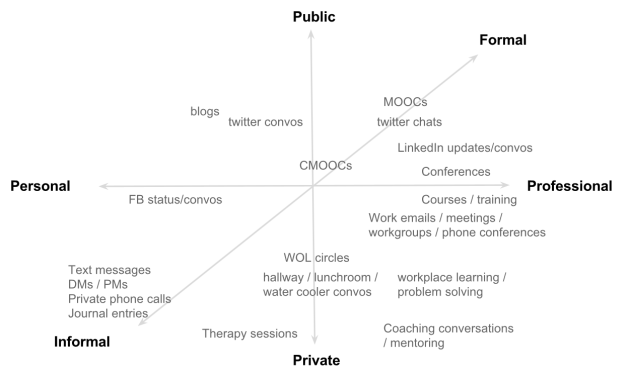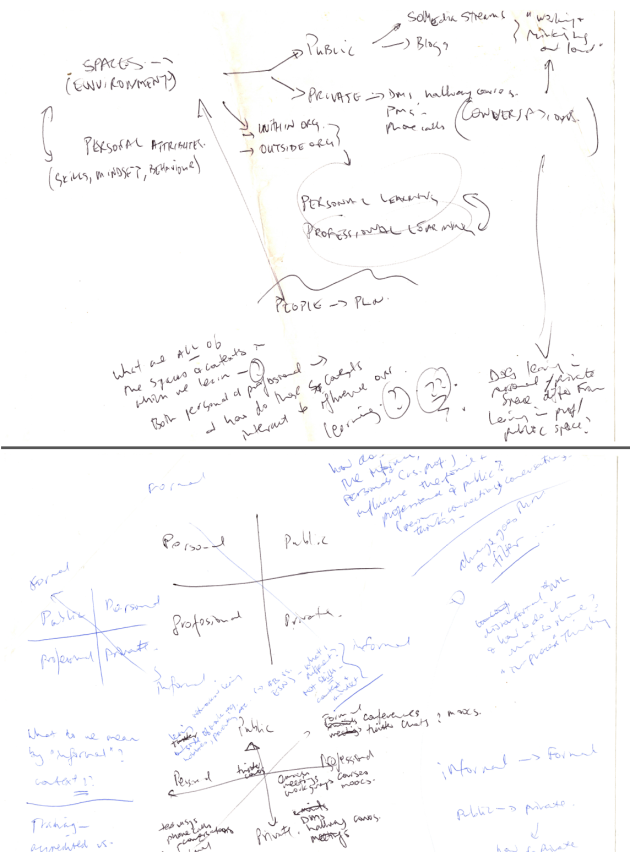Preface: this is a post I wrote back in March-April 2015 but hadn’t published as I’d wanted to create a more readable version of the diagram (yes. It took THAT long. Mainly because, as is often the case with draft / unpublished posts, I forgot about it then lost the momentum / motivation to go back to it). I’m digging into the blog draft archives and posting them without significant editing to try to develop a ‘WorkOutLoud’ attitude and become more comfortable with publicly sharing work-in-progress.
I’ve been thinking a lot about conversation spaces lately: public and private; online and offline; formal and informal places and spaces, and how each of these might support various ways of knowing and learning.
The seed of this thinking was planted by Kandy Woodfield’s excellent and thought provoking post last year on the ethics of (open) social learning and working out loud. Kandy’s post prompted me to start considering the role, pros/cons, and differences of open, public, professional learning spaces vs closed, private, personal ones – and how our learning across these contexts interact to influence our identity, connections, conversations, mindset and behaviour.
This thinking has been kick-started again as I’ve reflected on recent ongoing private conversations with a friend. This is a person I have only known for about 6 months, who less than 3 months ago I’d have called an acquaintance. The (what feels like) accelerated status from acquaintance to friend has occurred largely through these private conversations, in which we’ve explored complex topics at a personal level, through a variety of mediums: in-person conversations, text messages, email, phone calls. These conversations have been open, honest, challenging and confusing, where I’ve learnt as much about myself as I have about my friend; that have challenged me to think about things that I otherwise wouldn’t have (or wanted to); and inspired and supported me to change the way I approach certain situations.
It’s a personal learning experience that feels something like therapy, counselling, or coaching conversations – but without the formality or power dynamics inherent in these contexts. John Stepper’s WOL circles (based on Sheryl Sandberg’s ‘Lean in’ circles) – an informal model for peer coaching and support might be an apt comparison. But yet more emergent, organic (serendipitous?) – without the guidelines, explicitly articulated purpose, or group dynamic.
As learning practitioners and educators we often ponder how to achieve deep, personally meaningful learning that inspires and supports ongoing, long term behaviour change. The type of learning that – in an organisational context – translates not only to impacts on business measures, but broad and lasting cultural change. That in an educational context – might lead to a breakthrough transition: from uncooperative/disruptive students with low self esteem to enthusiastic students proud of their achievements with a newfound thirst for learning (This inspiring EdContexts post by Éllen Cintra is a great example). The type of learning that prompts individuals to examine within, reflect deeply, question long held beliefs, and change their behaviour or habits.
My instinct is that all of these learning experiences come about through similar underlying processes. I have been wondering about the characteristics of this type of profound learning: how it emerges, whether it could be achieved in an intentionally designed environment, and the conditions that are needed to facilitate it.
And what I’m thinking might drive this type of learning is conversation. Conversations of: openness. honesty. empathy, shared understanding. shared purpose, trust. Vulnerability. Acceptance. Mutual, ongoing support. Conversations that make you FEEL deeply as well as think deeply. That engender emotional, as well as cognitive connection. It may not be so much about finding a solution to a defined problem, as it is about uncovering, unravelling, & exploring complexity and supporting each other to figure out how and what might work.
Can environments be ‘designed’ to support this type of learning?
‘Design’ in this context is not about developing the right set of ‘learning resources’. It’s not about setting up an ESN (Enterprise Social Network) and hoping for the best – or manufacturing reasons for people to ‘interact’. It’s about creating the right type of ‘conversation space’ for these personally or professionally meaningful conversations (and learning > relationships > behaviour change) to emerge.
Here is a ‘back of the envelope’ set of conditions that I’m thinking might be important:
- Private or semi-private (e.g. a closed group) conversation spaces. High degrees of trust and vulnerability are critical for deep learning. This may be difficult (impossible?) to achieve in an open, public space. Personal conversations, private/direct/text messages, coaching or performance conversations, journals, WOL circles are all examples of private conversation spaces.
- In-person contact – maybe it’s possible to develop the same level of trust and vulnerability exclusively through online interactions, but I’m still not entirely sure (reflecting on this conversation on Terry Elliot’s blog re the nature of connection). At the least, it might take longer and be more difficult than if there were opportunities for face to face contact. More ‘present’ forms of online interaction like Google Hangouts, Skype or video calls might help bridge the gap.
- Regular, ongoing contact, ‘check-ins’ – this may be essential for the ‘change’ aspect of this learning – ongoing, mutual support, talking through issues, encouragement to try (and keep trying) different courses of action, following up and reflecting on what seems to work (or not) is a form of social accountability, and helps motivate, kickstart & continue behaviour change.
- Empathy / shared experiences and/or purpose – empathy can be so important for developing trust. Maybe because when empathy is present there is no judgement. Empathy might come from shared experiences and/or a shared purpose. Or might simply emerge from listening without judgement.
This is something I drafted a couple of months ago, to start mapping out some of this thinking. I always intended to post it as a ‘thinking out loud’ artifact, but wasn’t inspired to write the framing post and backstory for it until my personal conversations with my friend, and the conversation on Terry’s blog got me revisiting this thinking. (Thanks Terry – and thanks to my friend who has been integral to the backstory. I think you might know who you are).
These are the original scribblings and notes that the above diagram evolved from (you can see why I needed to convert it to a more legible format…):




Add a comment